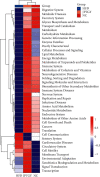Traditional Chinese Medicine Formula Jian Pi Tiao Gan Yin Reduces Obesity in Mice by Modulating the Gut Microbiota and Fecal Metabolism
- PMID: 35979004
- PMCID: PMC9377893
- DOI: 10.1155/2022/9727889
Traditional Chinese Medicine Formula Jian Pi Tiao Gan Yin Reduces Obesity in Mice by Modulating the Gut Microbiota and Fecal Metabolism
Abstract
The current study employed the high-fat diet (HFD) induced murine model to assess the relationship between the effect of Jian Pi Tiao Gan Yin (JPTGY) and the alterations of gut microbiota and fecal metabolism. C57BL/6 mice were used to establish an animal model of obesity via HFD induce. Serum biochemical indicators of lipid metabolism were used to evaluate the pharmacodynamics of JPTGY in obese mice. Bacterial communities and metabolites in the feces specimens from the controls, the Group HFD, and the JPTGY-exposed corpulency group were studied by 16s rDNA genetic sequence in combination with liquid chromatography-mass spectrometry (LC-MS) based untargeted fecal metabolomics techniques. Results revealed that JPTGY significantly decreased the levels of total cholesterol (TC), triglyceride (TG), low-density lipoprotein cholesterol (LDL-C), and elevated high-density lipoprotein cholesterol (HDL-C). Moreover, JPTGY could up-regulate the abundance and diversity of fecal microbiota, which was characterized by the higher phylum of proteobacteria. Consistently, at the genus levels, JPTGY supplementation induced enrichments in Lachnospiraceae NK4A136 group, Oscillibacter, Turicibacter, Clostridium sensu stricto 1, and Intestinimonas, which were intimately related to 14 pivotal fecal metabolins in respond to JPTGY therapy were determined. What is more, metabolomics further analyses show that the therapeutic effect of JPTGY for obesity involves linoleic acid (LA) metabolism paths, alpha-linolenic acid (ALA) metabolism paths, glycerophospholipid metabolism paths, arachidonic acid (AA) metabolism paths, and pyrimidine metabolism paths, which implied the potential mechanism of JPTGY in treating obesity. It was concluded that the linking of corpulency phenotypes with intestinal flora and fecal metabolins unveils the latent causal link of JPTGY in the treatment of hyperlipidemia and obesity.
Copyright © 2022 Wenchao Dong et al.
Conflict of interest statement
The authors declare no conflicts of interest.
Figures








Similar articles
-
Jian Pi Tiao Gan Yin alleviates obesity phenotypes through mTORC1/SREBP1 signaling in vitro and in vivo.Ann Transl Med. 2022 Mar;10(6):291. doi: 10.21037/atm-22-685. Ann Transl Med. 2022. PMID: 35433951 Free PMC article.
-
Traditional Chinese Medicine Formula Kang Shuai Lao Pian Improves Obesity, Gut Dysbiosis, and Fecal Metabolic Disorders in High-Fat Diet-Fed Mice.Front Pharmacol. 2020 Mar 25;11:297. doi: 10.3389/fphar.2020.00297. eCollection 2020. Front Pharmacol. 2020. PMID: 32269525 Free PMC article.
-
Naoxintong Capsule Alternates Gut Microbiota and Prevents Hyperlipidemia in High-Fat-Diet Fed Rats.Front Pharmacol. 2022 Mar 21;13:843409. doi: 10.3389/fphar.2022.843409. eCollection 2022. Front Pharmacol. 2022. PMID: 35387330 Free PMC article.
-
Buyang Huanwu decoction affects gut microbiota and lipid metabolism in a ZDF rat model of co-morbid type 2 diabetes mellitus and obesity: An integrated metabolomics analysis.Front Chem. 2022 Nov 9;10:1036380. doi: 10.3389/fchem.2022.1036380. eCollection 2022. Front Chem. 2022. PMID: 36438869 Free PMC article.
-
Ginsenoside Rc ameliorated atherosclerosis via regulating gut microbiota and fecal metabolites.Front Pharmacol. 2022 Sep 15;13:990476. doi: 10.3389/fphar.2022.990476. eCollection 2022. Front Pharmacol. 2022. PMID: 36188559 Free PMC article.
Cited by
-
Intestinal flora: A new target for traditional Chinese medicine to improve lipid metabolism disorders.Front Pharmacol. 2023 Mar 1;14:1134430. doi: 10.3389/fphar.2023.1134430. eCollection 2023. Front Pharmacol. 2023. PMID: 36937840 Free PMC article. Review.
-
An overview of traditional Chinese medicine affecting gut microbiota in obesity.Front Endocrinol (Lausanne). 2023 Mar 1;14:1149751. doi: 10.3389/fendo.2023.1149751. eCollection 2023. Front Endocrinol (Lausanne). 2023. PMID: 36936157 Free PMC article. Review.
-
Metagenomic and Untargeted Metabolomic Analysis of the Effect of Sporisorium reilianum Polysaccharide on Improving Obesity.Foods. 2023 Apr 7;12(8):1578. doi: 10.3390/foods12081578. Foods. 2023. PMID: 37107373 Free PMC article.
-
Chinese Sausage Simulates High Calorie-Induced Obesity In Vivo, Identifying the Potential Benefits of Weight Loss and Metabolic Syndrome of Resveratrol Butyrate Monomer Derivatives.J Nutr Metab. 2025 May 16;2025:8414627. doi: 10.1155/jnme/8414627. eCollection 2025. J Nutr Metab. 2025. PMID: 40415762 Free PMC article.
-
Bridging traditional Chinese medicine and Alzheimer's disease: the pivotal role of gut microbiota in multitarget therapeutic mechanisms.Front Pharmacol. 2025 Jun 27;16:1630205. doi: 10.3389/fphar.2025.1630205. eCollection 2025. Front Pharmacol. 2025. PMID: 40657642 Free PMC article. Review.
References
LinkOut - more resources
Full Text Sources
Research Materials
Miscellaneous

